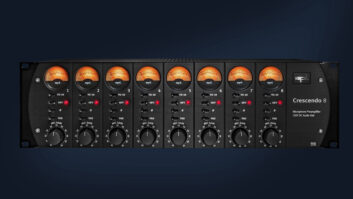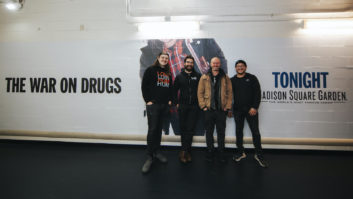Taking a hard detour in his Continuing Adventures In Software, Rich Tozzoli and friends put a selection of mono ribbon mics to the test as drum overheads.
Getting a great drum sound can involve many diverse factors. But one element that helps add power and focus to the overall image is the use of a mono room mic. And few are better suited for the job than a good ribbon. On a recent recording session up at Clubhouse Studios in Rhinebeck, NY, we decided to put a few different ribbons to the “mono” test and discovered some interesting results.
Setting up in the large live room on drummer Ray LeVier’s Yamaha kit, engineer/owner Paul Antonell lined up an array of ribbons that included a beyerdynamic M160, Royer 121 and an AEA KU 4 and AEA A440. All mics were run through his Neve 8058 MKII console directly into Avid’s Pro Tools at 24-bit/48 kHz with no EQ or compression. We set the mics up about 10 feet from the kit, about 6 feet high and pointed down towards the kick.
While certainly not an exact scientific test, it was a real-world analysis on a working session. These were simply the ribbons we had on hand! We put the mics fairly close to each other and judged them on overall sonic character. One thing that needs to be mentioned is that it’s a misnomer that every ribbon features a figure-8 polar pattern. With the mics we had, only the Royer 121 and AEA A440 are true figure-8 (meaning, of course, that sound will be captured both from the front and rear of the mic). The beyer M160 is hypercardioid and the AEA KU4 is supercardioid.
Listening to each mic alone, one after another, was quite fascinating. The AEA A440 was the biggest- and thickest-sounding. We used the word “wide” quite a bit, and it was also the darkest mic of the lot, with the most highs rolled off. Its brother, the AEA KU4, had less low end, but grabbed the snare and popped it out of the speakers. It had a nice sense of overall clarity. The beyer M160 was the most aggressive-sounding mic, with a slight pronounced upper mid boost that we guessed to be around 6-8 kHz. The Royer 121, we thought, had a great overall sound, and it made the kick super-tight and punchy. We also felt (of course, due to the polar pattern) that it brought out the room sound the most, but pleasantly.
Both Antonell and I tend to record with a ribbon mic on just about every session we do, especially on guitar cabinets and drums. With drums, we’ll set up that mono ribbon in front of the kit as a good focal point. Antonell tends to use the KU4 for such purposes (about 5 feet from the kick), but also adds in a pair of A440 room mics about 10 feet from the kit, approximately 10 feet high. Something I’ll do is add an 1176-style compressor (only in the mix, not to “tape”) to the mono ribbon and squeeze the sound quite hard, playing with the Input/Output, a 4:1 ratio and setting the Release to almost 5 o’clock. At that position, it grabs the drums and pushes them forward quite hard, which I call the “Zeppelin” sound. The only negative is that it can suck too much cymbal and hi-hat into the compression field, and make the sound crunchy, even with ribbon mics. So you have to adjust the Release and Input to taste.
Running these “test” mics through the 1176-style compressor, we found the A440 got even bigger, with even more bottom and a slightly enhanced high end. “Massive” was the word we used, and when mixed in with the rest of the kit, it was huge. Interestingly, the KU4 did not change character much; it was like the same mic, just a bit hotter. Once again though, it made the snare pop in a “clearer” way than the others did. You could compress it hard, blend it quite loudly into the overall mix, and it simply enhanced the sound without harsh artifacts.
The beyer M160 was edgy and punchy, and even more so when compressed. But it worked quite well, and added a lot of sparkle to the upper mids, just above the snare and below the hi-hats. There’s a reason that’s such a “go to” mic. The Royer 121 had a nice, smooth high end and when compressed, and we heard a great crack of the snare in the back of the room. It also delivered a supertight kick sound. In the mix, we all used the word “pleasant,” as it just made the overall sound better.
We came out of this “test” with a new appreciation for each of these mics. There certainly was no winner or loser. We agreed that ribbons have a special charm, and there’s a reason so many engineers turn to them for great results. Clearly, each had their own sonic character. Placing even a single ribbon in front of a drum kit and driving it hard with a good compressor can make a huge difference in the image and overall sound. And as Antonell wisely said, “None of these will hurt.”







